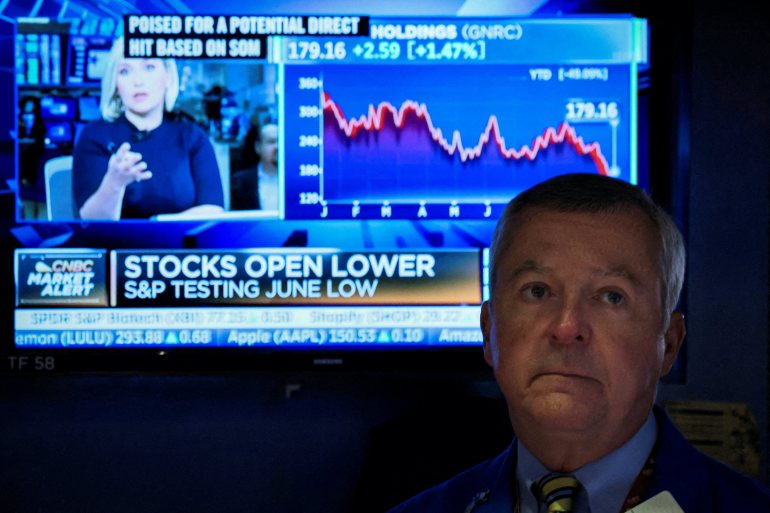Us Crude Continues Plunge in Bear Market
United States stocks slumped further this week as investors navigated a barrage of bad news.
Central banks around the world have been scrambling to fight soaring high inflation by increasing the cost of borrowing without hurting long-term growth prospects. Adding to the uncertainty and fear are rising tensions between the West and Russia following Moscow's invasion of Ukraine.
In the US, the S&P 500 – a proxy for the health of retirement and college savings accounts – this week fell to its lowest level in almost two years and was set for a monthly decline of nearly 8 percent.
The tech-heavy Nasdaq 100 has dropped nearly 33 percent so far in 2022, the Dow Jones Industrial Average lost more than 20 percent while the world's best-known cryptocurrency, Bitcoin, shed nearly 60 percent of its value. Home prices are also dropping as interest rates soar, making loans for potential buyers more expensive.
The Federal Reserve, the country's central bank, is tasked with fighting the highest inflation in decades and has been doing that by raising interest rates. But can it increase the cost of capital to reduce demand and moderate prices without plunging the economy into a deep recession?
"It's really a no-win situation at this point. Largely because of the number of shocks policymakers have had to deal with," Cristian deRitis, leading economist at Moody's, a research firm based in New York, explained to Al Jazeera.
How much further down can stocks go? What is a bear market exactly? And is there a light at the end of the tunnel?
Here's the short answer.
I keep hearing that the US is in a bear market. What is that exactly?
A bear market occurs when a broad market index dips more than 20 percent from recent highs.
Why is the US currently in a bear market?
"Persisting concerns over inflation and the Fed's ability to tame prices without a hard landing," is how Peter Essele, head of portfolio management at Commonwealth Financial Network, a Massachusetts-based firm, explained it.
What's the reason behind the high inflation and why are prices out of control?
Kenneth McLaughlin, professor of economics at Hunter College in New York, told Al Jazeera that one of the reasons is the federal government "injecting $5 trillion into the economy including through stimulus checks during the pandemic with kind of good intentions but with no plans to pay for it."
In other words?
Think back to early 2020 when businesses shuttered and economies came to a standstill to curb the spread of the coronavirus. Millions of Americans found themselves under lockdown with nowhere to go and spend the fresh-off-the-press stimulus checks. That caused equity prices, be it stocks, Bitcoin and home prices across the US, to skyrocket. It also caused a surge in demand for goods and that, as we see now, has led to the highest rise in the cost of living seen in decades.

How does this cause the stock market to go down?
As the Fed raises rates, which is essentially increasing the cost of borrowing in order to bring down the price of goods and services, people start to fear a slowdown in the economy. This pushes down the price of stocks and other investments.
Are the current economic conditions really just the consequence of what happened in the last 2 years?
The last two years have been unprecedented in many aspects. But what we are seeing today can also be attributed to the extremely low interest rates of the last decade when, following the financial crisis of 2007-2008, the government made it cheaper for Americans to borrow, Essele told Al Jazeera.
Didn't the markets just have a rally?
Stocks did experience a rally in August. Things were looking up when petrol prices, which had soared in earlier months, dropped sharply. Investors held on to the hope that perhaps the Fed would ease on the interest rate hikes if the inflation numbers for August showed that consumer prices had cooled. But despite cheaper petrol, food and other essential goods, prices remained high – surging 8.3 percent in August compared with a year earlier.
Where are we now?
"Inflation is becoming more structural and investors are now concerned about stagflation," Essele explained to Al Jazeera, suggesting that price hikes may be here to stay for the long haul. Stagflation is a mashup of the words "inflation" and "stagnation" and refers to a situation when inflation is high even as the rate of economic growth slows down.
So what does the future hold? And how long will this bear market last?
Expect above-average price pressures. The war in Ukraine and growing tensions between the West and Russia add to the uncertainty and will continue to spook investors and roil markets.
"But we are likely in three-quarters of the way through the bear market," Essele predicted.
I don't own any stocks, why should I care about a bear market?
While stock investors are the ones most directly affected by a US bear market, there are spillover effects to the rest of the economy primarily due to the "wealth effect". That is, as households see the value of their retirement and stock portfolios decline, they will pull back on their spending.
"Given how dependent the US economy is on consumer spending, this impact can be significant and widespread," Moody's deRitis told Al Jazeera. "Discretionary sectors such as travel, leisure, and hospitality may feel the most immediate effect but other industries such as housing and retail trade will experience reduced demand as households grow cautious."
Source: https://www.aljazeera.com/economy/2022/9/30/bear-market-what-it-means-and-how-long-the-us-may-be-in-one
0 Response to "Us Crude Continues Plunge in Bear Market"
Post a Comment